Andrea Macdonald founder of ideaXme interviews Professor Dr Pieter Roelfsema Director of the Netherlands Instititute for Neuroscience
Andrea Macdonald founder ideaXme: [00:06:52] I’m Andrea Macdonald, the founder of ideaXme.
Breakthrough towards developing technology to restore functional vision in the blind
Andrea Macdonald founder ideaXme [00:07:10] This episode concerns itself with a breakthrough towards developing a technology to restore functional vision to the blind. Paper: Shape perception via a high-channel-count neuroprosthesis published on 4 Dec 2020: Vol. 370, Issue 6521, pp. 1191-1196 DOI: 10.1126/science.abd7435. Authors: Xing Chen1,*, Feng Wang1, Eduardo Fernandez2, Pieter R. Roelfsema1,3,4,*
I’m here with the director of the Netherlands Institute for Neuroscience (NIN). Who are you?
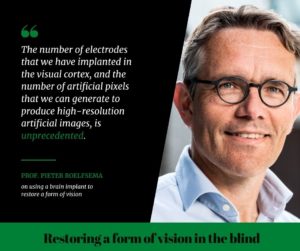
Professor Pieter Roelfsema Director Netherlands Institute for Neuroscience
Pieter Roelfsema Director NIN: [00:07:29] My name is Pieter Roelfsema. I studied medicine but if you feel ill, you don’t want me beside your bed. I went into science, studied the visual system. Few years ago, we thought: “Why not use knowledge all that knowledge we have accumulated. Why don’t we start thinking about creating a device that restores rudimentary form of vision for blind people?”.
How does a human being perceive vision?
Andrea Macdonald founder ideaXme: [00:07:54] There are over 40 million blind people worldwide, over 2 billion visually impaired (World Health Organisation), over 1 billion visually impaired, where this impairment could have been avoided. Could you explain the process through which a human being receives vision, or a non-visually impaired human being receives vision to the brain where it is perceived as such?
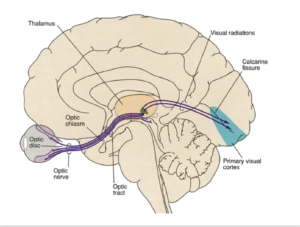
Pieter Roelfsema Director NIN: [00:08:28] So the information that comes into your eyes is a sharp image on the back of your eye where your retina is. Then the information from the retina is sent through the optic nerve to a region in the mid brain called the thalamus. And from there it’s sent on to the back of our brain. There’s a region that’s called primary visual cortex, and that region has a very accurate, two-dimensional representation of the outside world, where two points that are nearby in the outside world will map onto two points in your brain that are also nearby. So, it’s a very systematic map of the outside world.
Working with the visual cortex to restore functional vision in the blind
Andrea Macdonald founder ideaXme: [00:09:11] And could you talk a little bit about the solution that you are providing and how it doesn’t actually deal with addressing issues in the eye it deals with addressing issues in the brain or the back of the brain in the visual cortex?
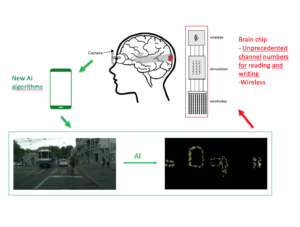
Pieter Roelfsema Director NIN: [00:09:34] What we know from previous work is that if you put an electrode in that region that I was just alluding to, the primary visual cortex, then you can put a little bit of current on it and you can stimulate the nerve cells that are nearby. An electrode is just a wire, actually. And so, these nerve cells will become active and a person, this can also be a person who has been blind for several years, will perceive a dot of light at that location that corresponds to the position of these two-dimensional map I was talking about. So, if you then stimulate with another wire, an electrode that is nearby, this person will see a dot of light that is close to the first dot of light. If you then have a whole series of wires, a whole series of electrodes, then you basically are addressing a part of the map and you can place dots in the person’s perception at many, many different locations and you can work with it like a matrix board. So, if I’m going to stimulate one electrode, you’re going to see a lot of light. But if you stimulate like in a matrix board if you switch on a single bulb you will see a dot. But on a matrix board you can also switch on several bulbs in the shape of a letter or convey other meaningful information. And we could do the same thing if you have many electrodes in the visual cortex, you can just switch on dot perceptions at many different locations and thereby convey meaningful information. Now, if a person would have such a prosthesis, which still needs to be developed further, this person would carry a camera. It could be embedded in glasses, then that kind of camera image will be sent to a processor, maybe the size of a phone that translates these camera images into brain stimulation patterns that are then going to be sent to those electrodes, maybe wirelessly.
Next steps to developing a technology to restore vision for the blind
Pieter Roelfsema Director NIN: [00:11:27] So that’s something also that needs to be developed. So, right now, the brain computer interfaces, many of them, they actually have a wire coming out of the skull to make the connection to the brain. Now, of course, in the future, a device that is safe and that can be used easily one would like all these things to be completely wireless.
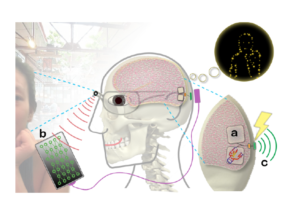
Why is this work a breakthrough?
Andrea Macdonald founder ideaXme: [00:11:48] Work in this area first started in the 1970s. Could you explain to the audience why the research that you head up represents such a breakthrough?
Pieter Roelfsema Director NIN: [00:12:02] Yes, so there was a fantastic researcher in the U.K., his name was Giles Brindley, he was already doing this in the 60s and in the early 70s. It’s really remarkable because he already made a system that was wireless.
Pieter Roelfsema Director NIN: [00:12:17] So basically, he had small coils, small kind of wire coils under the skin. Several of them actually more than one hundred.
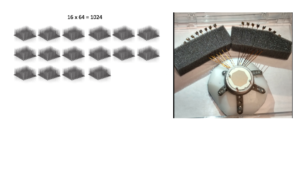
Pieter Roelfsema Director NIN: [00:12:26] And he then used a coil on the outside to induce current in a coil under the skin and then he ran a wire to the visual cortex and was able to stimulate brain cells. It was amazing that he could already do this back then, of course, we are now 50 years later, and we have improved technology, so our game is easier. We have better ways to interface with the brain, actually back then, he also put electrodes on the surface of the brain. We have found out that you can get perception’s with less current if you have electrodes inside the brain. And that’s an advantage. We have actually one thousand electrodes in the experiment that we recently did in monkeys. And so, we have basically more pixels from which we can build a mental image. And of course, there are other advances now. So, it’s better electrode technology. We have now wireless chips that can, of course, digest much more information. So, I think this is the right time to make to make this happen.
eBrains 3D brain and how it has helped to advance NIN’s research
Andrea Macdonald founder ideaXme: [00:13:33] Could you explain a little bit about how the eBrains 3D Brain Atlas has helped you to advance this research?
Pieter Roelfsema Director NIN: [00:13:45] Yes. So eBrains is part of The Human Brain Project. It is a collection of services that The Human Brain Project or its successor will offer to the neuroscience community. Now, for our research, we have to kind of take the shape of this visual cortex where we want to implant electrodes into account. The shape of the visual cortex is complicated. It has all kinds of folds. We call them sulci. And they are different from one individual to another, so we need to devise a strategy to implant electrodes, a sufficient number of electrodes, we’re thinking about thousands of electrodes and we want to make sure that most of them are positioned in the right location. And that’s where eBrains is tremendously helpful because they have the anatomical knowledge, and they can also provide some of the tools that allow us to do the correct mapping.
Andrea Macdonald founder ideaXme: [00:14:42] And you have mentioned in your paper that there are a number of issues that remain to be addressed.
Andrea Macdonald founder ideaXme: [00:14:52] And you’ve been very open about the fact that once this represents a breakthrough, you know, a lot more work needs to be done in this area. A couple of things you mentioned were a certain specific form of WIFI system needs to be developed. And you also mentioned that the whole area of tissue damage needs to be addressed. Could you talk about those two things, please?
Pieter Roelfsema Director NIN: [00:15:21] Yes. The electrodes are right now using they are stiff silicon electrodes.
Pieter Roelfsema Director NIN: [00:15:27] There is a mechanical mismatch between the brain tissue, which is soft and the stiff rods. And the impression has been, although this is not very well documented, is that this mismatch in mechanical properties caused this kind of sort of sliding between the electrodes and the brain tissue that then results in the build-up of tissue, glial tissue, sort of fibrous tissue that pushes the nerve cells away from the electrodes and thereby making it more difficult to stimulate the neurons. So, one way to go that seems promising is to use other materials that are much softer. So, one of them is Polyimide, which is sort of a plastic, which you can make very thin wires. And they seem then to be causing less damage than those silicon rods.
Pieter Roelfsema Director NIN: [00:16:22] So that’s one area where developments are currently taking place that look quite promising. The other point that you asked me to reflect upon is wireless systems. So also, there is tremendous developments there. There are systems that allow researchers to communicate with the brain, putting something under the skin and something above the skin that has enough bandwidth basically to allow communication at a high enough rate to make that possible. But also, there are definitely some developments to be further taken.
Andrea Macdonald founder ideaXme: [00:17:05] And the recent research that you’ve spoken about in your paper, I believe, has focused on using animals to test this technology. At what point, although I know that similar technologies have also been tested in humans, when do you see the earliest time that you can transition from animals to humans?
Transitioning to testing the technology on humans
Andrea Macdonald founder ideaXme: [00:17:28] Because, of course, there are many movements in the world that are against animal testing and whether it causes pain or not. There’s a great deal of discomfort about it. I’m just wondering what the plans are to transition this to humans?
Pieter Roelfsema Director NIN: [00:17:50] It would not be ethical to just do this in humans and just hope for the best. So, most people I talk to think that you first have to thoroughly test this. And some of this testing involves animals. And in this particular research, we had to use monkeys because they are the closest to humans and in monkeys, we could really test whether if you stimulate a pattern of electrodes in the visual cortex, they could recognize that as a pattern. This could not have been done in another species. Now, in collaboration and actually mainly driven by researchers in Spain, Eduardo Fernandez, who is also a co-author on our paper, we actually tested the same approach already in one human patients. There was an MIT Tech Review about it recently. And the good news is that many of these same stimulation patterns that we tried in monkeys also appeared to work in this in this particular individual. So, we’re actually already making this step. But if you want to use other electrode materials and also wireless chips, again, we first have to demonstrate that they can be used safely. And some of these things you can test without animals. But some of these tests really involve animals. And it’s even the legal requirement to demonstrate that this works in animals first. And I think that’s also only the only ethical way to do it. You cannot just put something in a human and hope for the best.
Andrea Macdonald founder ideaXme: [00:19:22] And the ideaXme audience is comprised of the general public, future innovators and creators, as well as the actual people who are shaping our world from the space industry right the way through to science, arts and philosophy. It would be really interesting to hear at this point, particularly for future innovators within your sector, to hear a little bit about your human story and your journey to this point. And as far as who maybe sparked your interest in this area and who influenced you and the choices you made along the way to get here.
Inspiration to work in Neuroscience
Pieter Roelfsema Director NIN: [00:20:08] Ok, that’s a very broad question. And so, I started studying medicine and at some point, I didn’t see myself as a medical doctor. So, I was really interested in science. And then I read a book called Gödel, Escher, Bach: An Eternal Golden Braid, written by Douglas Hofstadter, which was mainly about consciousness. And I thought, this is a really interesting topic that I want to spend time on. This is what I really would like to do. So then at some point during my studies, I already started to do some neuroscience work just as a volunteer. And then I already applied to do a PhD project with Wolf Singer, Director the Max Planck Research Institute in Frankfurt. He said, well, why don’t you first finish your studies? So that’s what I did.
Pieter Roelfsema Director NIN: [00:21:04] I went back to the Netherlands or to where I studied, and I completed my studies hoping that he would remember that he said that I would be welcome in his lab after I completed my studies and he had not forgotten. So, I was really pleased to be part of his lab. And he was probably one of the people who influenced me the most. I had a wonderful time doing PhD research in that lab. And after that, I just continued the neuroscience. I did a lot of work just on pure vision, just trying to understand how vision works.
Pieter Roelfsema Director NIN: [00:21:43] Through those studies, I think I started to read also more about prosthetics. Another person that I enjoyed talking to and who influenced me was Jens Neumann. He was one of the people in the program of Bill Dobelle, who also had a visual prosthesis program. And was one of the subjects. He had a cortical implant. It didn’t work for very long. He’s still a very inspiring person. And talking to him also inspired me to continue in this direction.
Team who helped create a breakthrough in developing technology to restore vision to the blind
Andrea Macdonald founder ideaXme: [00:22:21] Could you talk a little bit about the team that you’re currently working with in their various roles in helping move this forward?
Pieter Roelfsema Director NIN: [00:22:29] Yes, so we started this visual cortical prosthesis project, I think, in 2014. Then Xing Chen, who is the first author on the paper, joined the group. And with her, we really started to do this work. We got a lot of help from a company, Blackrock Microsystems, which helped us design the implants and make sure that we could do this for 1000 channels because that had not been done before. And after that, several other people joined the lab, Feng Wang who was also a co-author on the paper. We established contact with Eduardo Fernandez, I have already mentioned him. They’re doing this work in Spain. And now the team that works on visual prosthesis is about six people in the lab. And we also started a company, Phosphoenix, because we realized that if you really want to put something in patients, you also need a commercial entity for various regulatory issues.
Andrea Macdonald founder ideaXme: [00:23:29] Pieter Roelfsema, thank you very much for your time and thank you for moving the human story forward. It’s been an absolute pleasure.
Pieter Roelfsema Director NIN: [00:23:39] Thanks a lot. My pleasure.
Credit: Andrea Macdonald founder ideaXme.
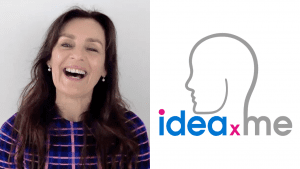
If you enjoyed this interview you might also like Dr Michael Mannino’s interview with the Human Brain Project.
Follow ideaXme on Twitter: @ideaxm
On Instagram: @ideaxme
Find ideaXme across the internet including on iTunes, SoundCloud, Radio Public, TuneIn Radio, I Heart Radio, Google Podcasts, Spotify and more.
ideaXme is a global podcast, creator series and mentor programme. Our mission: Move the human story forward!™ ideaXme Ltd.
